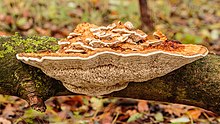Fomitopsis quercina
| Fomitopsis quercina | |
|---|---|

| |
| The maze-like pores[1] of Fomitopsis quercina | |
| Scientific classification | |
| Domain: | Eukaryota |
| Kingdom: | Fungi |
| Division: | Basidiomycota |
| Class: | Agaricomycetes |
| Order: | Polyporales |
| Family: | Fomitopsidaceae |
| Genus: | Fomitopsis |
| Species: | F. quercina
|
| Binomial name | |
| Fomitopsis quercina (L.) V. Spirin & O. Miettinen
| |
| Synonyms[2] | |
Fomitopsis quercina is a species of mushroom in the order Polyporales. Commonly known as the thick-walled maze polypore,[3] maze-gill fungus oak-loving maze polypore, or oak mazegill, the specific epithet refers to the oak genus Quercus, upon which it frequently grows, causing a brown rot.[4] It is found in Europe, Asia, Northern Africa and Australasia. Though inedible, it can be used as a natural comb and has been the subject of chemical research.
Having previously been in the genus Daedalea, it was transferred to the new genus Fomitopsis in 2024, based on molecular phylogenetic data. The newly proposed name is Fomitopsis quercina (L.) Spirin & Miettinen (2024).[5]
Description
[edit]
The sessile, fan-shaped fruiting bodies are typically 3–20 centimetres (1.2–7.9 in) in diameter and up to 8 centimetres (3.1 in) thick. They are found singly or in tiered groups, usually on rotting oak. The upper surface of the cap may be various shades of brown, and is sometimes zonate. The pore surface, white to tan in color, is initially porous, but as the fruit body matures, some of the pore walls break down, forming slits with blunt partitions.[citation needed] This results in the characteristic maze-like (daedaloid or labyrinthinine/labyrinthiform) appearance.[1] The tube walls are 10–30 mm (0.39–1.18 in) long, with thick walls. The basidiospores are 5–7 × 2–4 μm, smooth, and elliptical in shape. In deposit the spores are white.
This mushroom is inedible[6] due to its cork-like texture.
A variant has been described that has large, angular pores similar to those in the genus Trametes, named F. quercina forma trametea.[7]
Habitat and distribution
[edit]Although Fomitopsis quercina prefers to grow on Quercus species, it has also been found on the tree species Fagus grandifolia, Fraxinus americana, Juglans nigra, and Ulmus americana.[8]
It has been reported from nearly all European countries, following the pattern of oak distribution. It has also been reported in Northern Africa, North America, (Tunisia), Asia from Caucasus to India, and also Australia.[9]
Uses
[edit]Fruit bodies of Fomitopsis quercina have been used as a natural comb and aphrodisiac, employed for brushing down horses with tender skin.[10] Gilbertson notes that in England, smoldering fruit bodies were used for anesthetizing bees.[11]
This species has been investigated for application in bioremediation.[12] The lignin-degrading enzyme laccase, isolated and purified from F. quercina, has shown use in biodegrading a variety of toxic dyes and pigments.[13]
The compound quercinol (a chromene derivative), isolated from the oak mazegill, has anti-inflammatory activity, and inhibits the enzymes cyclooxygenase-2, xanthine oxidase, and horseradish peroxidase.[14]
References
[edit]- ^ a b Kent H. McKnight; Vera B. McKnight (1987). A Field Guide to Mushrooms: North America. Houghton Mifflin Harcourt. p. 236. ISBN 0-395-91090-0.
- ^ Fomitopsis quercina in MycoBank.
- ^ Arora, David (1986). Mushrooms demystified: a comprehensive guide to the fleshy fungi (Second ed.). Berkeley: Ten Speed Press. ISBN 978-0-89815-169-5.
- ^ Perley Spaulding (1961). Foreign Diseases of Forest Trees of the World: An Annotated List. U.S. Government Printing Office. p. 84.
- ^ Spirin, V.; Runnel, K.; Vlasák, J.; Viner, I.; Barrett, M.D.; Ryvarden, L.; Bernicchia, A.; Rivoire, B.; Ainsworth, A.M. (2024-03-15). "The genus Fomitopsis ( Polyporales , Basidiomycota ) reconsidered". Studies in Mycology. 107 (1): 149–249. doi:10.3114/sim.2024.107.03. ISSN 0166-0616. PMC 11003443. PMID 38600960.
- ^ Phillips, Roger (2010). Mushrooms and Other Fungi of North America. Buffalo, NY: Firefly Books. p. 312. ISBN 978-1-55407-651-2.
- ^ Schanzle, R. W. (1973). "Daedalea quercina forma trametea in Illinois". Mycologia. 65 (3): 689–690. doi:10.1080/00275514.1973.12019478.
- ^ Overholts, L. O. (1939). "Geographical Distribution of Some American Polyporaceae". Mycologia. 31 (6): 629–652. doi:10.1080/00275514.1939.12017381.
- ^ Kotlaba F. (1984). Zeměpisné rozšiřeni a ekologie chorošů (Polyporales s. l.) v Československu [The range and ecology of Polyporales species in Czechoslovakia Republik]. Věd. Česk.Akad. Praha.
- ^ Rolfe F. (1974). The Romance of the Fungus World: an Account of Fungus Life in its Numerous Guises, both Real and Legendary. New York: Dover Publications. ISBN 0-486-23105-4. p. 158.
- ^ Gilbertson, Robert L. (1980). "Wood-Rotting Fungi of North America". Mycologia. 72 (1): 1–49. doi:10.1080/00275514.1980.12021153.
- ^ Asgher M; Bhatti HN; Ashraf M; Legge RL (November 2008). "Recent developments in biodegradation of industrial pollutants by white rot fungi and their enzyme system". Biodegradation. 19 (6): 771–83. doi:10.1007/s10532-008-9185-3. PMID 18373237. S2CID 40336521.
- ^ Baldrian P. (February 2004). "Purification and characterization of laccase from the white-rot fungus Daedalea quercina and decolorization of synthetic dyes by the enzyme". Appl. Microbiol. Biotechnol. 63 (5): 560–3. doi:10.1007/s00253-003-1434-0. PMID 14504838. S2CID 24279274.
- ^ Gebhardt, P.; Dornberger, K.; Gollmick, F.A.; Gräfe, U.; Härtl, A.; Görls, H.; Schlegel, B.; Hertweck, C. (2007-05-01). "Quercinol, an anti-inflammatory chromene from the wood-rotting fungus Daedalea quercina (Oak Mazegill)". Bioorg. Med. Chem. Lett. 17 (9): 2558–60. doi:10.1016/j.bmcl.2007.02.008. PMID 17346963. Retrieved 2024-11-18.
